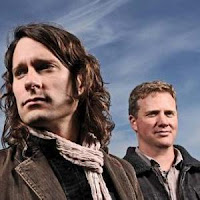1994: Reno Meets Jay Krasnow
While working on The Hopefuls: Chasing a Rock ‘n’ Roll Dream in the Minnesota Music Scene – a story so sprawling and multi-faceted that each of its four principals could easily have a whole book to themselves – I knew I was going to miss some things.
Case in point, in June 2020, I received an e-mail from Jay Krasnow, who revealed that he had served as Spymob’s very first manager, before they were even Spymob. Jay is a multi-instrumentalist and composer who spent 10 years in the Twin Cities scene producing, playing, and co-engineering for a wide variety of artists. He happened across The Hopefuls by chance in a public library in Cleveland, where he now makes his home (I must say it warmed my heart to hear that the book is in libraries in “The Rock ‘n’ Roll Capital of the World”), and realized that he had a missing piece of the story to share.
Jay and I chatted on the phone about his memories and impressions of his brief time with Eric Fawcett, John Ostby, Brent Paschke, and Brian Roessler. I thought I would write his story as sort of a director’s cut restored scene. Print out a copy, fold it up, and insert it on page 29 of The Hopefuls.
*
In 1994, a St. Paul-by-way-of-California native named Jay Krasnow was in the middle of trying to make it in the music business. A musician himself, he’d started what he calls “an ill-conceived business model” of managing up-and-coming local musicians on the condition that he also produce their recordings. This would lead him to work with an eclectic roster of artists including Little Tin Gods, James Grant, and Mike Lane. Most of Jay’s producing work happened at a small studio in Minneapolis that became known as OarFin, and eventually expanded into a label and a distributor. Among the demo cassette tapes that arrived daily at OarFin was the three-song Reno EP.
Jay was astonished by the level of craftsmanship in the songwriting and performance, and by how very different it was from the grunge and alt-rock bands that were ascendant at the time. Looking at the photo Reno in the cassette insert, Jay realized that he’d encountered two of the band members before. While interning at Metro Studios in early 1993, he’d witnessed – and been duly impressed by – Brent Paschke playing guitar in a session with an R & B band, laying down tunes such as Steely Dan’s “Green Earrings” and Tower of Power’s “Don’t Change Horses (In the Middle of a Stream).” In early 1994 Jay had been served by Fawcett at French Meadow, and his “genial and sweet-mannered” approach to customer service stuck in Jay’s mind. Based on Fawcett's prominent place in the Reno cassette photo, Jay wrongly assumed he was the lead singer.
Jay met with the band and was immediately struck by the steely-determination that lay underneath their easygoing and polite natures. Jay and the band bonded over their mutual friend, Alex Oana, whom Jay had met when Alex was doing sound work at the likes of the Mirage and the Fine Line. Risking sabotaging his own efforts to represent them – and not knowing that John had just relocated from Los Angeles – he told the band they were “too good and too proficient” for Minneapolis and should move to California. The Reno guys, for their part, were hungry for gigs and exposure, and excited to have someone with experience expressing interest in helping them.
In October 1994, not long after Brian joined the band, Jay and Reno signed a three-month representation agreement. Jay set about getting the band gigs. Their first paid performance took place in April 1995 at a downtown Minneapolis architecture firm called Hammel, Green, and Abrahamson. They wore suits, stayed on their best behavior, and were paid $250 for their efforts. The gigs that followed were more traditional, at the likes of the University of Minnesota Student Center, Mears Park in St. Paul, Lee’s Liquor Lounge, and the Fine Line. Jay also landed Reno an appearance on local commercial TV.
But finding the right audience for the band proved difficult, and Reno’s grander ambitions chafed against Jay’s “a bird in the hand is worth two in the bush” philosophy of taking smaller, tactical gigs. Concurrently, Jay’s manager/producer business model was becoming untenable. In a streak of bad luck, four of the ten artists he represented would call it quits by the middle of 1995. Jay gave up on his management aspirations and ended his association with Reno, though he’d continue to produce and play with various local artists. Fawcett, Ostby, Brent, and Brian, meanwhile, were laser-focused on what was next, namely a full-length album and a new name.



Comments
Post a Comment